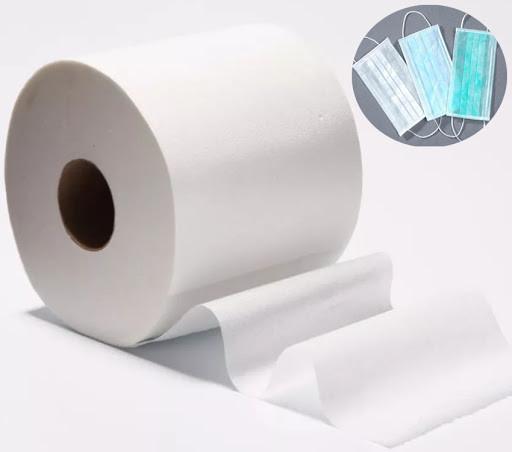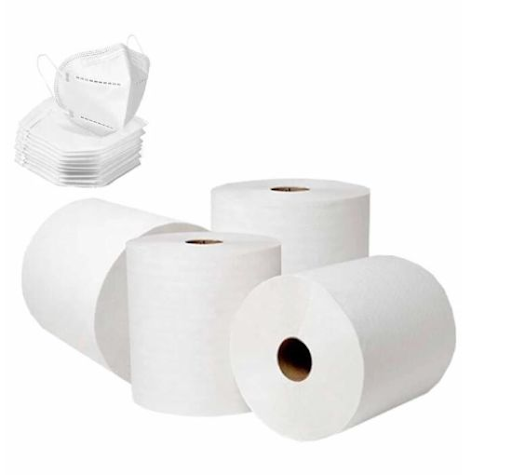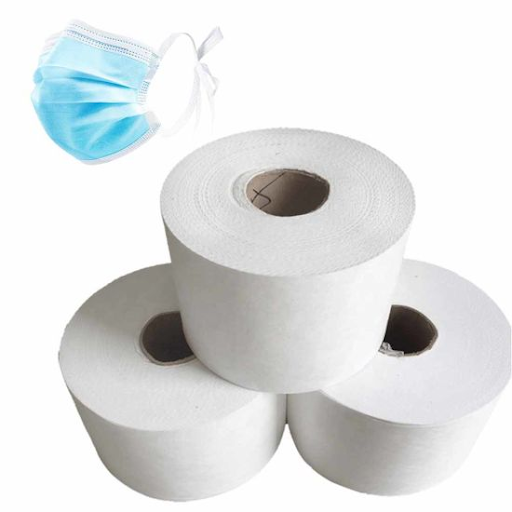Buy Melt Blown Polypropylene Nonwoven Fabric From China Manufacturer
Melt blowing is a traditional micro-and nanofiber production technology in which a polymer melt is extruded via small nozzles while being surrounded by high-speed blowing gas. The fibers are randomly placed to create a non-woven sheet product that can be used for filtration, sorbents, clothing, and medicine delivery.
The simplicity, high specific productivity, and solvent-free operation are all significant advantages of melt blowing. Scientists created melt-blown fibers with an average diameter of 36 nm by using the right combination of polymers with optimum rheological and surface properties.

Contents
- 1 A small history of melt blowing
- 2 Meltblown Polypropylene Nonwoven Fabric for FFP2 Melt Blown Fabric
- 3 What is Melt blown Fabric?
- 4 PP Meltblown Nonwoven Fabrics: Uses & Applications
- 5 PP melt is blown Fabric Filter Media for Masks
- 5.0.1 Flat Masks
- 5.0.2 PP Spunbond Nonwoven Fabric, PP Meltblown Nonwoven Fabric, and an outer layer of another PP Spunbond Nonwoven Fabric are generally used to make these masks. For improved skin feel, one of the layers can typically be replaced with staple fiber.
- 5.0.3 Three-Dimensional Cup Masks:
- 6 Melt Blown Fabric for Mask Good Or Bad
- 7 What is the Difference between Melt blown and Non-Woven Fabrics?
- 8 Is Melt blown Fabric washable?
- 9 Conclusion
A small history of melt blowing
Pele’s hair is a fibrous substance extracted from molten basaltic magma by strong winds during volcanic activity. Melt blowing of polymers experiences the same phenomena. In the 1950s, a naval endeavor to produce fine filtering materials for radiation readings aboard drone aircraft in the United States marked the beginning of melt-blowing research.
Exxon Corporation later created the first industrial melt blowing process with high throughput levels, based on the Melt blowing principle. China manufactures 40% of the world’s non-woven Fabric, with Hebei province producing most of it (2018).
Meltblown Polypropylene Nonwoven Fabric for FFP2 Melt Blown Fabric
FFP2 Melt blown non-woven fabrics are commonly used to produce industrial dust-proof face masks, cup-shaped face masks, polypropylene melt-blown cloth, and other protection face masks. 30g/sm to 75g/sm, two or three layers combined, are the most commonly utilized weights. It has a big dust capacity, good permeability, low resistance, high filtering effectiveness, and other properties that allow it to absorb dust particles effectively.
FFP2 Melt blown non-woven textiles are primarily used in outdoor labor, painting, construction, agriculture, animal husbandry, food processing, sanitation workers, cement factories, textile factories, cutting dust, and workplaces with heavy metal hazardous pollutants. It effectively separates and absorbs dangerous industrial dust, preventing silicosis and reducing industrial dust injury to human organs. To safeguard life and safety by avoiding or reducing dust from entering the human body’s respiratory organs.
What is Melt blown Fabric?
Polypropylene or PP melt blown Nonwoven Fabric is manufactured of Polypropylene and has a 1 to 5 microns fiber diameter. It has good oil absorption, heat insulation, filtration, and shielding capabilities. For PP melt-blown non-woven Fabric, you can get various anti-wrinkle fluffy structures and voids.
It has uses in many filtration industries such as air filters, face masks, N95 face masks, water, and other industries due to its filtration properties and distinct capillary architectures of the ultra-fine fibers. It has exquisite qualities due to its complex fiber structure, enhancing the surface area and the number of fibers per unit area.

PP Meltblown Nonwoven Fabrics: Uses & Applications
Meltblown fabrics are commonly used in the following applications:
- Isolation materials
- Air Filtration Equipments
- Mask materials – N95 Masks, PPE Kit, Coverall for Healthcare Industry
- Liquid filtering materials
- Thermal insulation materials
- Absorbing materials
- Wiping cloths
- Oil-absorbing materials
PP melt is blown Fabric Filter Media for Masks
Flat Masks
PP Spunbond Nonwoven Fabric, PP Meltblown Nonwoven Fabric, and an outer layer of another PP Spunbond Nonwoven Fabric are generally used to make these masks. For improved skin feel, one of the layers can typically be replaced with staple fiber.
Three-Dimensional Cup Masks:
PET needle-punched polyester cotton fabric, Meltblown Nonwoven Fabric, and PP Spunbond non-woven or needle-punched cotton textiles make these masks. The outer layer is usually a non-woven fabric that has been waterproofed.
The melt-blown midsection is made of Meltblown Nonwoven fabric that has been specifically processed. It possesses exceptional oil absorption, shielding, filtration, and heat-insulating qualities. Standard non-woven Fabric makes up the inner layer. From all the above analysis, it is evident that Meltblown Nonwoven Fabric plays a crucial role in mask production, although every mask has its role to play.

Melt Blown Fabric for Mask Good Or Bad
To answer this, we need to take a step back and consider why people wear masks in the first place. A mask is just a face net. Like a mosquito net, this net keeps negative things out. The net mesh must be small for the net to be successful in preventing bad things from leaking within.
So, how do you tell the difference between “cloth” and “melt-blown fabric”? Knits and woven fabrics are manufactured differently, with woven fabrics consisting of a succession of strings linked together in various formations. On the other hand, Melt Blown Fabric is a stack of excellent plastic strands placed on top of one another.
What is the Difference between Melt blown and Non-Woven Fabrics?
Meltblown fabrics
Meltblown Fabric is made primarily of Polypropylene, with fiber diameters ranging from 1 to 5 microns. Many gaps, a fluffy texture, and solid folding resistance are all present. These ultrafine fibers have a unique capillary structure that increases fibers per unit area and their specific surface area.
Make the melt-blown Fabric filterable, shieldable, heat-insulating, and oil-absorbent. Air, liquid filtration textiles, insulators, absorption materials, mask materials, thermal insulation materials, oil-absorbing materials, and wipes can all benefit from it.
The filter material is a type of melt-blown polypropylene microfibers with distributed unequally knots that stick collectively, white appearance, smooth, 0.5-1.0 material soft fiber density, random distribution of fiber fibers provides more opportunities for heat bonding.
As a result, a melt-blown gas filter material with a greater specific surface area and porosity (75%) was created. The product has low resistance, high efficiency, and high dust holding capacity after very high-pressure filtering efficiency.
Non-woven Fabric
Directional or random fibers make up non-woven Fabric. Because of its look and specific product features, it is known as cloth.
Moisture-proof, breathable, flexible, lightweight, non-combustible, easy to decompose, non-toxic and non-irritating, colorful, affordable, recyclable, and so on are some of the benefits of non-woven Fabric. Using Polypropylene (pp) particles as raw material, for example. Melting, spinning, spreading, hot pressing, and coiling are all done at the same time.
Non-woven fabric characteristics:
There are no warp and weft threads in non-woven fabrics. They’re easy to cut and sew with, and they’re light and easy to shape.
Because if a fabric can be made without spinning or weaving, just the textile short fibers or filaments are analyzed, oriented, or randomly organized to create a web structure. Then, we use traditional machinery, thermal bonding, chemical, etc., to complete the process. It is necessary to reinforce the method.
It is not interwoven with yarn, but the fibers are physically connected, so if you acquire a sticky name on your clothes, it will not be able to pull a thread out. Non-woven fabrics defy traditional textile principles by having a short process flow, quick production speed, high output, low cost, widespread use, and diverse raw material sources.
Is Melt blown Fabric washable?
Polypropylene Fabric is a contemporary fabric that is used for upholstery, industrial, and manufacturing purposes. Polypropylene has no active dye sites, making it soft, lightfast, and easy to clean. It’s also highly durable and can be washed with bleach, even if the colors are dark.
Conclusion
Although each mask has its role to play, it is clear from the above study that Meltblown Nonwoven Fabric plays an essential part in mask creation.

 By Coco Ho
By Coco Ho

